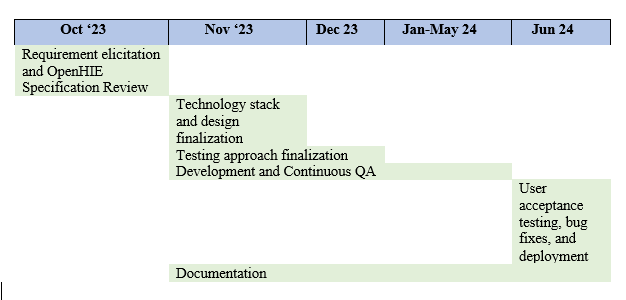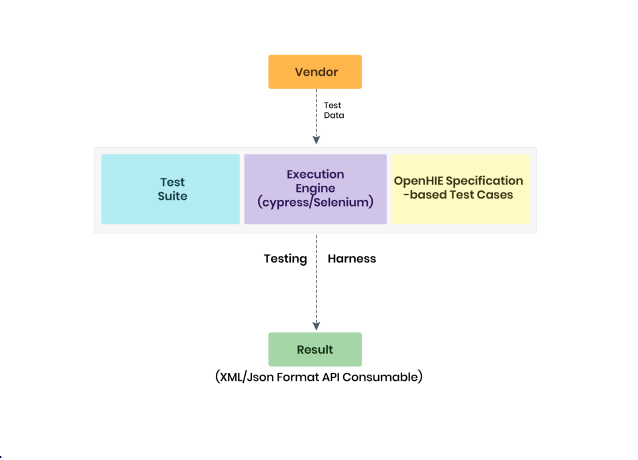OpenHIE Testing Harness and Test Framework: Difference between revisions
No edit summary |
No edit summary |
||
| (3 intermediate revisions by one other user not shown) | |||
| Line 1: | Line 1: | ||
A Health Information Exchange (HIE) makes the sharing of health data across information systems possible. Like a universal translator, an HIE normalizes data and secures the transmission of health information throughout databases, between facilities, and across regions or countries. | A Health Information Exchange (HIE) makes the sharing of health data across information systems possible. Like a universal translator, an HIE normalizes data and secures the transmission of health information throughout databases, between facilities, and across regions or countries. | ||
==Background== | |||
The OpenHIE community has collaboratively developed a HIE architecture. Several software applications have been identified as reference applications that implement parts of the specification, and they work together as components of the OpenHIE Architecture Specification. There has been no empirical way to test the compliance of these technologies to the architecture specification. This testing approach should evaluate the ability of these tools to meet the | |||
* Interoperability requirements | |||
* Functional requirements and to a degree | |||
* Non-functional requirements. | |||
Digital Square, under its mandate to promote the development, adoption, and reuse of global goods, and helps increase their availability, adaptability, and maturity has contracted Argusoft India Ltd. [https://argusoft.com/] to develop a harness and complete test framework that will facilitate testing the conformance of technologies to the OpenHIE Architecture specification and health and data content, as specified by WHO SMART Guidelines. | |||
The resulting solution will be leveraged by other software applications and tools, and as such should have a permissive open-source license as it may be leveraged by vendors developing OpenHIE/SMART Guidelines compliant software and other teams, such as the WHO Digital Health Clearinghouse and the local country validation laboratories to test compliance of digital health solutions to WHO SMART Guidelines compliance requirements and/or their defined requirements. | The resulting solution will be leveraged by other software applications and tools, and as such should have a permissive open-source license as it may be leveraged by vendors developing OpenHIE/SMART Guidelines compliant software and other teams, such as the WHO Digital Health Clearinghouse and the local country validation laboratories to test compliance of digital health solutions to WHO SMART Guidelines compliance requirements and/or their defined requirements. | ||
| Line 24: | Line 27: | ||
procedures through which tests are designed and implemented. | procedures through which tests are designed and implemented. | ||
</blockquote> | </blockquote> | ||
==Vision== | ==Vision== | ||
The testing harness and test framework will use the Gherkin language to describe the test features (cases). It will also at the minimum have the test execution engine, the test scripts and test data. The overall technology stack to be used is yet to be decided at this time, and the stack will be shared here after it is agreed upon. | The testing harness and test framework will use the Gherkin language to describe the test features (cases). It will also at the minimum have the test execution engine, the test scripts and test data (See draft architecture diagram below). The overall technology stack to be used is yet to be decided at this time, and the stack will be shared here after it is agreed upon. | ||
==Roadmap== | ==Roadmap== | ||
The project is expected to through the end of June 2024 according to the timeline below. | The project is expected to run through the end of June 2024 according to the timeline below. | ||
[[File:Testing-harness-time-line.PNG|800px|Development timeline]] | [[File:Testing-harness-time-line.PNG|800px|Development timeline]] | ||
| Line 46: | Line 47: | ||
The meetings will take place at the OpenHIE DevOps calls [https://wiki.ohie.org/display/CP/DevOps+Subcommunity+Calls], and on the OpenHIE Architecture and Standards calls [https://wiki.ohie.org/pages/viewpage.action?pageId=11370513]. | The meetings will take place at the OpenHIE DevOps calls [https://wiki.ohie.org/display/CP/DevOps+Subcommunity+Calls], and on the OpenHIE Architecture and Standards calls [https://wiki.ohie.org/pages/viewpage.action?pageId=11370513]. | ||
The community and all other interested stakeholders are highly encouraged to participate. | The community and all other interested stakeholders are highly encouraged to participate. | ||
==Global Goods response to COVID-19== | |||
[[COVID-19|Read more here]] about the adaptions made by global goods to support COVID-19 response activities. | |||
Latest revision as of 12:36, 27 June 2024
A Health Information Exchange (HIE) makes the sharing of health data across information systems possible. Like a universal translator, an HIE normalizes data and secures the transmission of health information throughout databases, between facilities, and across regions or countries.
Background
The OpenHIE community has collaboratively developed a HIE architecture. Several software applications have been identified as reference applications that implement parts of the specification, and they work together as components of the OpenHIE Architecture Specification. There has been no empirical way to test the compliance of these technologies to the architecture specification. This testing approach should evaluate the ability of these tools to meet the
- Interoperability requirements
- Functional requirements and to a degree
- Non-functional requirements.
Digital Square, under its mandate to promote the development, adoption, and reuse of global goods, and helps increase their availability, adaptability, and maturity has contracted Argusoft India Ltd. [1] to develop a harness and complete test framework that will facilitate testing the conformance of technologies to the OpenHIE Architecture specification and health and data content, as specified by WHO SMART Guidelines.
The resulting solution will be leveraged by other software applications and tools, and as such should have a permissive open-source license as it may be leveraged by vendors developing OpenHIE/SMART Guidelines compliant software and other teams, such as the WHO Digital Health Clearinghouse and the local country validation laboratories to test compliance of digital health solutions to WHO SMART Guidelines compliance requirements and/or their defined requirements.
Testing Harness
Digital Square refers to a test harness as a collection of tools and data used to test an application for conformance to a defined specification. The test harness is envisaged to be comprised of the test execution engine, test scripts and data used in testing with a clear separation of concerns between components.
The testing harness will be comprised of test execution engines and test script repositories. A test execution engine is the software used to perform the test, not the software being tested. The test script repository is the location where test scripts and cases are stored. The results are to be collated and presented as a report.
Not to be confused with a test framework, a testing harness is the collection of software and test data used to test a digital health solution (software), whereas test frameworks are the set of processes and procedures through which tests are designed and implemented.
Vision
The testing harness and test framework will use the Gherkin language to describe the test features (cases). It will also at the minimum have the test execution engine, the test scripts and test data (See draft architecture diagram below). The overall technology stack to be used is yet to be decided at this time, and the stack will be shared here after it is agreed upon.
Roadmap
The project is expected to run through the end of June 2024 according to the timeline below.
Documentation and Architecture
This is the architecture that is currently proposed. This architecture is subject to change as the development progresses.
The documentation will be developed and published on the web. Once complete, the link to the published documentation will be shared here.
Contributing
The development of the testing harness and test framework will be open to the community. The Argusoft team will meet twice a month to provide progress updates and to also get community feedback. The meetings will take place at the OpenHIE DevOps calls [2], and on the OpenHIE Architecture and Standards calls [3]. The community and all other interested stakeholders are highly encouraged to participate.
Global Goods response to COVID-19
Read more here about the adaptions made by global goods to support COVID-19 response activities.


